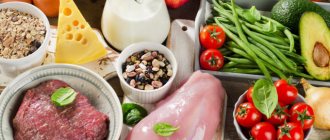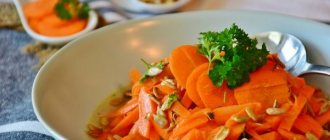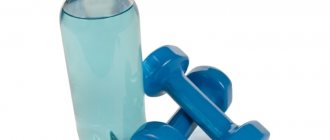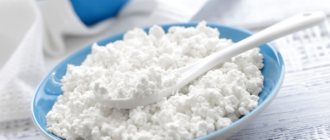The variety of types of cabbage that is present on store shelves today is amazing. Moreover, some of them do not even outwardly resemble cabbages familiar from childhood. And this is not at all a quirk of breeders. Many of the varieties of the cruciferous family have come down to us from ancient times. In particular, cauliflower was allegedly developed by the peasants of Crete 2.5 thousand years ago. Europeans became acquainted with it only in the 12th century, and seeds of this vegetable began to be brought to Russia from Malta for huge money only during the reign of Catherine the Great. What are the benefits and harms of this amazing vegetable, which received its name not at all for its special color, but for its external resemblance to a flower? Read more about the beneficial properties and contraindications.
Chemical composition and benefits of cauliflower
Cauliflower compares favorably with other members of the cruciferous family in its diversity, as well as the amount of vitamins and minerals.
Table: chemical composition and vitamins in raw and boiled cauliflower (per 100 g)
| Raw | Boiled | |
| Calorie content | 25 kcal | 32 kcal |
| Squirrels | 1.92 g | 1.84 g |
| Fats | 0.28 g | 0.45 g |
| Carbohydrates | 4.97 g | 4.11 g |
| Alimentary fiber | 2 g | 2.23 g |
| Water | 92.07 g | 93 g |
| Ash | 0.76 g | 0.6 g |
| Mono- and disaccharides | 1.91 g | 2.08 g |
| Lutein+zeacantip | 1 mcg | 29 mcg |
| Thiamine (vitamin B1) | 0.05 mg | 0.042 mg |
| Riboflavin (vitamin B2) | 0.06 mg | 0.052 mg |
| Choline (vitamin B4) | 44.3 mg | 39.1 mg |
| Pantothenic acid (vitamin B5) | 0.667 mg | 0.508 mg |
| Pyridoxine (vitamin B6) | 0.184 mg | 0.173 mg |
| Folic Acid (Vitamin B9) | 57 mcg | 44 mcg |
| Ascorbic acid (vitamin C) | 48.2 mg | 44.3 mg |
| Tocopherol (vitamin E) | 0.08 mg | 0.07 mg |
| Phylloquinone (vitamin K) | 15.5 mcg | 13.8 mcg |
| Niacin (vitamin PP) | 0.507 mg | 0.41 mg |
| Potassium | 229 mg | 142 mg |
| Calcium | 22 mg | 16 mg |
| Magnesium | 15 mg | 9 mg |
| Sodium | 30 mg | 15 mg |
| Phosphorus | 44 mg | 32 mg |
| Iron | 0.42 mg | 0.32 mg |
| Manganese | 0.155 mg | 0.132 mg |
| Copper | 39 mcg | 18 mcg |
| Selenium | 0.6 mcg | 0.6 mcg |
| Zinc | 0.27 mcg | 0.17 mcg |
It is quite natural that having such a composition, it cannot but have special properties. So, why should you definitely include this product in your diet?
This unusual vegetable got its name not for its unusual color, but for its resemblance to a flower.
Beneficial properties for the whole family
- Cauliflower is useful for diseases of the stomach and duodenum. Its juice has a wound-healing and antibacterial effect.
- It will help normalize digestion for people suffering from low acidity of gastric juice.
- The fiber in cauliflower perfectly cleanses the intestines and restores its microflora. In addition, regular consumption of this vegetable helps reduce the level of “bad” cholesterol.
- Cauliflower is indispensable in the diet of people with pathologies of the heart and blood vessels. Allicin, which it contains, will help prevent strokes and heart attacks, and potassium will support the functioning of the heart muscle and maintain normal blood pressure.
- Vitamin K and fatty acids in this plant have anti-inflammatory properties and help cope with various arthritis and arthrosis.
For women
- This product will help beautiful ladies effortlessly maintain a slim figure or get rid of extra pounds. Low calorie content, together with a fairly high protein content, makes it a very popular product for everyone losing weight.
- Cauliflower holds the record for vitamin C content among other varieties of this plant. In turn, it helps not only maintain immunity, but also maintain youthful skin. More precisely, this is done by collagen, the synthesis of which is also activated by ascorbic acid.
- Regular consumption of this vegetable can reduce the risk of breast cancer.
During pregnancy
- Folic acid in cauliflower dishes will help the normal course of pregnancy and reduce the risk of fetal pathologies.
- Tartronic acid in this vegetable prevents excess weight gain, which very often becomes a critical factor in this delicate condition.
- Calcium promotes the normal development of the skeletal system of the unborn baby, and also keeps the woman’s bones, teeth and hair intact.
- Cauliflower is also recommended during pregnancy because vitamin K in its composition reduces the risk of uterine bleeding.
When breastfeeding
Cauliflower is hypoallergenic and, as a rule, does not cause unpleasant reactions from the baby's intestines during breastfeeding. Its use allows you to diversify the menu of a nursing woman and prepare the child for the future introduction of complementary foods.
Cauliflower dishes are recommended for pregnant women and while breastfeeding.
For men
Cauliflower reduces the risk of prostate cancer.
Scientists from Canada have proven that if you consume just half a glass of this vegetable (boiled) daily, the risk of colon or bladder cancer is reduced by 50%.
For children
Vitamin C will help strengthen the child’s immunity, and a serving of 50 g of cauliflower will provide the necessary amount for the normal functioning of all systems. In addition, this vegetable is one of the few sources of vitamin K, which children need for the normal functioning of the blood coagulation system.
Energy and nutritional value per 100 grams
The calorie content of 100 g of product is 25 kcal. The nutritional value of cabbage is 69.3 g carbohydrates, 26.8 g protein and 3.9 g fat. The inflorescences of the plant contain B vitamins, ascorbic and nicotinic acids, retinol and biotin. The vegetable contains minerals and organic acids:
- citric, malic and tartronic acids;
- calcium;
- magnesium;
- iron;
- sodium;
- potassium;
- phosphorus.
Advice
The vegetable is rich in starch, vegetable protein, sugars and fiber.
How much is it possible?
For healthy people, there are no restrictions on the amount of cauliflower. It is noted that you can safely eat up to 1.5 kilograms of boiled vegetables per day. If you prefer a fresh product, then it is better to reduce its quantity by 2 times. Even if we take into account that the fiber of cauliflower, compared to its white cabbage relative, is quite easily digestible, in large quantities and without heat treatment it is quite capable of causing intestinal disorders.
And all this is one single vegetable!
Of course, this type of cabbage is enriched with a whole range of various substances beneficial to the body. They simply have a wonderful effect on the digestive system, the proper functioning of which is important in the process of losing weight.
This vegetable contains less coarse fiber compared to other varieties - for example, cabbage. Therefore, cauliflower is absorbed in the body much faster and does not irritate the gastric and intestinal mucosa. Moreover, it helps to correct the functioning of the intestines, while simultaneously cleansing it of accumulated toxins.
In order to lose weight, it is best to eat fresh cabbage inflorescences. You can eat them just like that, without anything, and you can also cook light soups and broths with them.
The nuances of eating a delicious vegetable
Healthy people do not need to limit this product
Waiting for a child
If a woman is a big fan of this type of cabbage, you can include it in your diet almost every day, without limiting the quantity. However, it is quite difficult to eat more than 200-300 g of this product at one time - cauliflower perfectly saturates even in a small portion and keeps you feeling full for a long time. If the expectant mother was not previously familiar with dishes from it, then they should be introduced into the menu carefully. Despite the fact that this type of cabbage is considered hypoallergenic, individual intolerance still occurs, so it is better to start getting acquainted with it with small (50 g) portions. If after eating them no disorders appear (flatulence, rash, heartburn, bowel movements), then the size of the dishes can be increased without fear.
Cauliflower can be boiled, steamed, baked or fried. The beneficial properties in it are fully preserved during any type of heat treatment. But fried foods should still be limited, as they place a much greater burden on the liver and pancreas. Also, do not consume this vegetable in salted or pickled form.
Nursing mother
The beneficial properties of this product will be in great demand during breastfeeding. And don’t be scared - unlike its white cabbage relative, cauliflower does not provoke flatulence and bloating. But in order to avoid unpleasant surprises, you need to follow several rules.
To be sure that cauliflower will not cause any surprises, you can introduce it into your menu only 3-4 weeks after the baby is born. This should be done carefully, adding cauliflower to those products that have long been used in the diet. The amount of vegetable in the first 2-3 days should not exceed 50 g. If the baby does not react in any way to the appearance of a new product in the mother’s diet, the portion can be gradually increased, but its size does not need to exceed 200 g. If allergy symptoms appear, introduce cauliflower It's better to put it off for 3-4 weeks and then try it again.
During breastfeeding, cauliflower can be boiled, steamed, or baked. Fried, pickled and salted dishes from this vegetable are not recommended.
How to feed
Doctors consider this vegetable the most suitable for first complementary feeding.
Cauliflower is one of the few vegetables that are ideal for introducing complementary foods. It will be especially useful for babies prone to anemia or constipation. Usually, complementary foods are introduced at six months, but if the child is not gaining weight well, then it is better to postpone introduction to vegetables for another month.
Complementary feeding starts with 0.5 tsp. puree made from cauliflower. If the baby tolerates the new product well, then every other day the portion is doubled. So, over a week, the volume of complementary foods is increased to 30–40 g. Gradually, its amount should be equal to the norms recommended by pediatricians.
- At 6 months they are 100 g;
- in 7 – 150 g;
- in 8 – 180 g;
- at 9, 10, 11, 12 months - 200 g.
At the very beginning of getting to know a new product, after the baby eats cabbage puree, he needs to be supplemented with breast milk. This will make it easier for him to learn an unfamiliar dish. 2 weeks after the introduction of complementary foods, you can add 1-2 ml of vegetable oil to the dish.
Another important point - before feeding, the child needs to be given 2 tsp. plain boiled water. And when preparing, you should not bring the puree to a completely homogeneous consistency. A small amount of fiber will help increase intestinal motility and avoid constipation.
If, in response to cauliflower puree, the baby develops bloating, stool changes, or any other alarming signs appear, introduction to this product should be postponed for several weeks.
Contraindications for use
It is prohibited to use cauliflower for weight loss in the following cases:
- gout;
- individual intolerance;
- gastritis with increased acidity of gastric juice;
- acute enterocolitis;
- hypothyroidism;
- frequent spasms of intestinal smooth muscles;
- in the period after surgery in the chest and abdominal cavity;
- teenagers and older people.
Attention!
Losing weight is prohibited during pregnancy and lactation.
In these cases, women can consume cauliflower as part of their normal diet.
To stay healthy
Cauliflower can be used to prepare not only delicious dishes, but also remedies for certain diseases.
Constipation, loss of appetite
To normalize stool and restore appetite, drink 50 g of sauerkraut juice before meals, but you can simply eat 2-3 fermented inflorescences.
Peptic ulcer
You can get rid of problems with the stomach and duodenum if you drink 0.5 cups of the juice of this vegetable. This should be done three times a day, an hour before meals. The course is 1 month. Please note that the juice retains its properties only for 24 hours, so you should not prepare it in large quantities. At the end of the course, take a two-week break and repeat the treatment.
This remedy will also help cope with gastritis with reduced gastric secretion.
For hemorrhoids
If you slightly heat the pickled cauliflower brine and drink 1/3 cup of it an hour before meals twice a day, you can get rid of hemorrhoids.
How to choose a product to cook?
To choose the right cauliflower for weight loss, you need to follow several recommendations:
- The head of cabbage is heavy and hard to the touch. The fresh vegetable has a dense inflorescence structure. They should not fall apart in your hands.
- A head of cabbage is usually surrounded by dense, rich green leaves.
- The inflorescences have a white or purple tint. The composition of both varieties is the same. The color of cabbage indicates the environment where the vegetable grew: white means full sun, purple means shady areas.
- You should not buy cabbage with pronounced dark spots. This indicates an infection or the beginning of rotting.
Cauliflower retains its beneficial properties for 10 days. After this time, the foliage around the head of cabbage dries up and becomes lethargic.
For gourmets
Light soup
A light vegetable soup will not only fill you up, but also get rid of extra pounds.
- 1 head of cauliflower;
- 2–3 potatoes;
- 4–5 tbsp. l. rice;
- 2.5 liters of water;
- 1 carrot;
- 1 onion;
- 3 tomatoes;
- 40 g vegetable oil;
- salt, pepper, herbs to taste.
Rice is thoroughly washed under running water. Potatoes, carrots and onions are peeled and chopped. Dip diced potatoes, rice and half of chopped onions and carrots into boiling water. Bring the soup to a boil again, reduce heat and simmer for 15 minutes.
Cauliflower is separated into inflorescences and washed. Tomatoes are grated. In a heated frying pan, fry the other half of the carrots and onions, add grated tomatoes and simmer under the lid for 5-10 minutes. Place the finished roast and cauliflower into the broth being prepared, add salt and pepper, let it boil and cook for 10 minutes. on the lowest heat.
Cauliflower soups are not only tasty, but also a very healthy dish. When cooked, some of the nutrients and vitamins go into the broth, which is why it takes on most of the healing properties of this vegetable.
Cauliflower baked with minced meat
This tasty and satisfying dish can be easily prepared even by an inexperienced housewife.
- 1 head of cauliflower;
- 500 g minced meat;
- 1 carrot;
- onion - 2 pcs.;
- 1 egg;
- 4 cloves of garlic;
- 2 tbsp. l. sour cream;
- grated cheese, salt, spices - to taste.
Grate the carrots, chop the onion and add vegetables to the minced meat. Chopped garlic and a raw egg are also placed there. The mass is salted, spices are added and mixed gently. The baking dish is lined with foil, onto which the minced meat is placed.
Head of cauliflower for 5 minutes. dipped in boiling water, cooled slightly under running cold water and disassembled into inflorescences, which are evenly placed on top of the minced meat. The top of the dish is greased with sour cream and placed for 40 minutes. into an oven preheated to 180°. When the time is up, remove the pan from the oven, sprinkle with cheese and bake for another 10 minutes.
Video: How to pickle cauliflower
Basic rules of use
When losing weight, you should adhere to several principles when consuming cauliflower:
- With fractional meals, it is recommended to eat up to 300 g of inflorescences per meal. With a three-course diet, it is allowed to increase the portion to 450-500 g.
- Whenever possible, you should eat fresh vegetables raw.
- You can boil the cabbage in water or steam it, or bake it in the oven. In this case, it is important to reduce the heat treatment time, because with prolonged exposure to high temperatures, tartronic acid is destroyed.
- Do not overuse salt and spices. The best option would be to avoid any food additives.
- You should drink a glass of water 30 minutes before eating. The next intake of liquid is allowed only after 45 minutes after eating.
Reviews about the application
I grow cauliflower in my dacha myself! I really like to eat it. Last summer I followed such a three-day diet with cabbage! Well, really, I changed it a little, so to speak, I adjusted it to suit myself! I added boiled chicken breast and extended the diet for a week! I didn’t feel hungry at all, I ate tasty and nutritious! My goal was not even to lose weight, but to somehow unload my body after constant summer feasts with barbecue! I succeeded and felt great!
Oksana Tim
https://your-diet.ru/?p=1126
I love cauliflower very much and in August - September I freeze it for future use throughout the winter. After any holidays, I unload on it, two to three days on cauliflower and broccoli from a steamer, albeit with salt. But it still helps. But on ordinary days, I still cook it at least once a week for everyone at home, and we don’t have any fat people.
Christina
https://jhealth.ru/all-diets/dieta-na-tsvetnoy-kapuste/
Cauliflower is a unique vegetable. This is where doctors recommend starting a child’s introduction to adult food. It is beneficial for men and women and can relieve many health problems. In addition, it is simply an amazingly tasty and tender product.
How to quit a diet without harm to your health?
After long-term weight loss, you should quit within a week to consolidate the results:
- In the first 2 days you need to continue to eat according to the diet rules:
- cauliflower;
- fruits;
- vegetables;
- leafy greens.
- After 48 hours, grains, lean meats and dairy products can be introduced into the diet.
- On the 4th-5th day you are allowed to eat bread.
- On days 6-7, you should completely switch to a normal diet.
Advice
After leaving the cauliflower diet, it is recommended to have weekly fasting days.
They will help cleanse the body of toxins. To prevent weight gain again, you need to balance your diet and adhere to a healthy lifestyle.
Use in folk medicine
Cabbage juice is used for medicinal purposes
In folk medicine, vegetables are used to prepare medicines.
For atherosclerosis: 200 ml of beet, cabbage, carrot juice, 50 ml of lemon and horseradish juice, vodka, and 20 g of honey mixed in a bottle. Store the resulting mixture in the cold and take 30 ml 3 times a day half an hour before meals.
For vitamin deficiency: mix 150 ml of apple juice with 100 ml of cabbage juice. Drink once a day for a month.
For gum inflammation: until complete recovery, rinse your mouth with a solution of cabbage juice mixed with water in a 1:1 ratio.
For cardiovascular diseases: 300 ml of cabbage juice and 150 g of horseradish mixed with 20 g of honey and 10 g of chopped parsley. Drink 100 ml twice a day for a month.
To prevent cancer: drink 150 ml of cauliflower juice 3 times a day for a month. The course is repeated every two months.
To improve immunity: mix 100 ml of carrot and cabbage juice with 30 g of honey and 250 ml of milk. For 30 days, drink 50 ml 20 minutes before meals 3 times a day.











